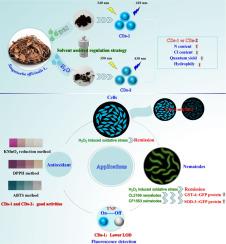Solvent assisted regulation of the properties of Sanguisorba officinalis L. derived carbon dots: Application in antioxidant, fluorescence imaging and fluorescence detection
IF 5.7
3区 材料科学
Q2 MATERIALS SCIENCE, MULTIDISCIPLINARY
引用次数: 0
Abstract
Novel carbon dots (CDs-1) were synthesized using Sanguisorba officinalis L., as a precursor and a deep eutectic solvent (DES) as both solvent and dopant. For comparison, CDs-2 were prepared under identical conditions but using water as solvent. Chemical analyses reveal that two CDs possess well-defined crystalline structures and are rich in diverse functional groups. Notably, DES-mediated synthesis endows CDs-1 with advantageous features compared to CDs-2, including higher N and Cl contents, enhanced hydrophilicity, and superior optical properties. To evaluate their potential biomedical applications, antioxidant capacities of them were investigated through in vitro and in vivo assays. Results demonstrated that both CDs exhibit potent free radical scavenging activity, strong KMnO4 reduction capability, and notable anti-cellular oxidative damage effects. Importantly, CDs-1 show superior performance in enhancing oxidative stress resistance at nematode level. Furthermore, owing to the exceptional optical characteristics, CDs-1 hold great promise for bioimaging applications and sensitive detection of 2,4,6-trinitrophenol (TNP).

溶剂辅助调控血地黄碳点的性质:在抗氧化、荧光成像和荧光检测中的应用
以地榆为前驱体,以深共晶溶剂(DES)为溶剂和掺杂剂,合成了新型碳点(CDs-1)。为了比较,在相同的条件下,以水为溶剂制备了cd -2。化学分析表明,这两种cd具有明确的晶体结构和丰富的不同官能团。值得注意的是,des介导的合成使CDs-1具有比CDs-2更有利的特性,包括更高的N和Cl含量,增强的亲水性和优越的光学性质。为了评估其潜在的生物医学应用,通过体外和体内实验研究了它们的抗氧化能力。结果表明,两种CDs均具有较强的自由基清除能力、较强的KMnO4还原能力和显著的抗细胞氧化损伤作用。重要的是,cd -1在线虫水平上表现出优异的抗氧化性能。此外,由于优异的光学特性,cd -1在生物成像应用和2,4,6-三硝基苯酚(TNP)的灵敏检测方面具有很大的前景。
本文章由计算机程序翻译,如有差异,请以英文原文为准。
求助全文
约1分钟内获得全文
求助全文
来源期刊

Materials Research Bulletin
工程技术-材料科学:综合
CiteScore
9.80
自引率
5.60%
发文量
372
审稿时长
42 days
期刊介绍:
Materials Research Bulletin is an international journal reporting high-impact research on processing-structure-property relationships in functional materials and nanomaterials with interesting electronic, magnetic, optical, thermal, mechanical or catalytic properties. Papers purely on thermodynamics or theoretical calculations (e.g., density functional theory) do not fall within the scope of the journal unless they also demonstrate a clear link to physical properties. Topics covered include functional materials (e.g., dielectrics, pyroelectrics, piezoelectrics, ferroelectrics, relaxors, thermoelectrics, etc.); electrochemistry and solid-state ionics (e.g., photovoltaics, batteries, sensors, and fuel cells); nanomaterials, graphene, and nanocomposites; luminescence and photocatalysis; crystal-structure and defect-structure analysis; novel electronics; non-crystalline solids; flexible electronics; protein-material interactions; and polymeric ion-exchange membranes.
 求助内容:
求助内容: 应助结果提醒方式:
应助结果提醒方式:


